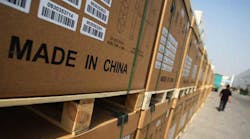China’s exporters are shrugging off the surging yuan, even as it nears its strongest level since 2015.
Growth in outbound shipments is expected to build on January’s double-digit increase to climb 6% in 2018, though the yuan has posted a 9% gain over the past year. While a rising domestic currency over time makes exports more expensive, trade isn’t suffering yet.
Things that can explain trade’s robust performance despite the relative costliness of the yuan: strong external demand, active hedging and a shift toward more high-tech products. Resilience in exports is much needed, as a deleveraging drive and deteriorating China-U.S. trade relations still threaten the sustained expansion of the world’s second-largest economy.
"Strong external demand is the dominating factor supporting China’s exports growth, which will remain resilient throughout this year thanks to global economic recovery," said Nathan Chow, senior economist at DBS Bank Hong Kong Ltd. "As long as the yuan’s appreciation is orderly and gradual, it will not dent outbound shipment significantly."
The yuan traded at 6.3050 per dollar late Monday in Shanghai, close to a level it had last visited in 2015 before China rocked global markets through a surprise devaluation of the currency.
Here are four factors that will shield exports from a surging yuan:
Demand to Stay Strong
Some of China’s largest trading partners, including the U.S., Japan and Germany, have been enjoying a strong economic recovery, with the three nations’ manufacturing purchasing managers indexes climbing in the past year, showing expansion. The growth momentum will continue to boost China’s exports this year, providing that a recent sell-off of global stocks and bonds doesn’t return with a vengeance, according to DBS’s Chow.
Peers Are Rising Too
The yuan’s rally against the currencies of its main trading partners, apart from the dollar, hasn’t been that steep, meaning China’s exported goods are actually not becoming as pricey everywhere. The Bloomberg replica of the CFETS RMB Index, which measures the Chinese exchange rate against 24 peers, climbed 1.2% this year, trailing the currency’s more than 3% appreciation versus the greenback. The yuan is still weaker against peers than it was at the start of 2016.
"In trade-weighted terms, it has not moved a lot," said Louis Kuijs, chief Asia economist at Oxford Economics in Hong Kong. "The competitiveness of Chinese exporters against their key competitors globally has not worsened much."
Exporters Hedge More Than Ever
China’s exporters have become more adept at using hedging tools to defend their profits. Jake Tai, a manager at a winter footwear maker in the eastern city of Nanjing, is settling more deals in yuan and euro, using currency forwards to reduce foreign-exchange risks and shortening the length of sales agreements to one month or quarter from one year previously.
"Those tools are like a down coat in the winter," said Li Liuyang, a Shanghai-based analyst at China Merchants Bank Co. who forecast the ratio of trade orders settled in yuan and euro to increase this year. "China’s exporters are much more adept at changes and challenges now."
More Value-Added Exports
China’s outbound shipments have become less sensitive to increases in the yuan over the years, as an increasing portion of the products are so-called value-added re-exports, said Iris Pang, an economist at ING Groep NV in Hong Kong. That means local companies first import parts for production and then sell the final goods overseas, so they benefit from currency appreciation as the costs of raw materials are lower, she said.
High value-added electronics and equipment manufacturing exports increased quickly in 2017, with the outbound shipment of locally made vehicles surging 27.2% and that of computers jumping 16.6%, Huang Songping, the spokesman of the General Administration of Customs said in a briefing last month.
By Bloomberg News



